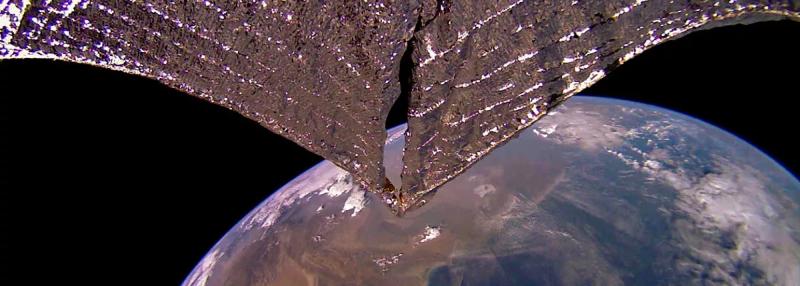 LightSail 2, the Planetary Society‘s solar sailing spacecraft, is no more. On November 17th, the crowdfunded solar sailing spacecraft burned in a blaze of glory as it re-entered earth’s atmosphere after traveling 8 million kilometers (5 million miles) powered only by sunlight.
LightSail 2, the Planetary Society‘s solar sailing spacecraft, is no more. On November 17th, the crowdfunded solar sailing spacecraft burned in a blaze of glory as it re-entered earth’s atmosphere after traveling 8 million kilometers (5 million miles) powered only by sunlight.
“LightSail 2 is gone after more than three glorious years in the sky, blazing a trail of lift with light, and proving that we could defy gravity by tacking a sail in space,” said Bill Nye, CEO of The Planetary Society in a statement. “The mission was funded by tens of thousands of Planetary Society members, who want to advance space technology.”
LightSail 2 hitched a ride to space in June 2019 aboard a SpaceX Falcon Heavy rocket. It began operations at an altitude of about 720 kilometers (450 miles), where Earth’s atmosphere is still thick enough to create drag and slow down a spacecraft. For reference, the International Space Station orbits at an altitude of roughly 400 kilometers (250 miles).
As atmospheric drag slowly pulled LightSail 2 back towards Earth, the spacecraft successfully used solar sailing to lower its decay rate and on occasion overcome drag completely. After 18,000 orbits, drag finally won out, bringing the mission to a close.
“During its extended mission LightSail 2 continued to teach us more about solar sailing and achieved its most effective solar sailing, but that was followed by an increase in atmospheric drag in part from increasing solar activity,” said Bruce Betts, LightSail program manager and chief scientist for The Planetary Society. “The spacecraft is gone, but data analyses and sharing of results will continue.”
LightSail 2 launched as a shoebox-sized spacecraft with its sails tucked together like origami. Using four tape measure-like booms, the spacecraft unfurled a four-section Mylar sail with an area of 32 square meters (244 square feet) — about the size of a boxing ring.
Light has no mass, but it has momentum that can be transferred to a reflective solar sail. The resulting push is small but continuous, allowing a spacecraft like LightSail 2 to change its orbit.
The LightSail mission team will continue to analyze data collected during the mission, publishing peer-reviewed journal articles, making conference presentations, and conducting public outreach. Images from the mission can be viewed online.
Results will continue to be shared with other upcoming solar sail missions such as NEA Scout and ACS3. In a fitting bookend to the LightSail 2 mission, NEA Scout launched on Nov. 16 aboard NASA’s Artemis I mission to the Moon. The Planetary Society shares data with the NEA Scout team through a Space Act Agreement.

Awesome!
“During its extended mission LightSail 2 continued to teach us more about solar sailing and achieved its most effective solar sailing, but that was followed by an increase in atmospheric drag in part from increasing solar activity,”
So what brought it to Earth was what could make it go faster in space?
For all of us that hang on forecasts, Radio 4 in the past, apps on our mobiles now, will the universe be divided into areas and instead of Viking, Fitzroy, Malin we shall have Orion, Taurus, Kuyper Belt only they extend light years into space. A three dimensional forecast? Wow!
Battening down the hatches for a Solar Storm, different!
Now, as a racing yachtsman will we also have beating, reaching and running with all the sail selections. Cool.
As a young boy and man back in the 1950’s I read SciFi stories of craft using light sails to traverse our Solar system. I was hoping they would be bigger than a shoe box but alas I’ll probably be dust or ashes by the time one takes flight.